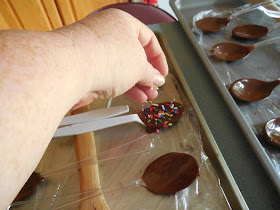Halloween is populated with many characters the most popular
are witches. But Fairies are often
associated with Halloween too, now most fairies are considered shy and
withdrawn hiding in gardens and enjoying blooms, but a more mischievous version
of a fairy is called a hobgoblin, often considered to be fearsome creatures, that
historically just brought bad luck. But there are three deadly herbs that are
often found in literature about Halloween Witches. Incense is often burned by
witches and those conducting magic. An incense
made with frankincense, myrrh and dill was used to ward off hobgoblins.
 |
| Hobgoblin beer logo |
A selection of other herbs are often associated with being
used to create mischief as well, some are even poisons, yet still used in some
magick and healing.
These three herbs are often called the witching herbs,
perhaps because each can cause hallucinations:
Henbane Hyoscyamus
niger
Hyoscyamus niger, commonly
known as henbane, black henbane or stinking nightshade,
is a poisonous plant in the family Solanaceae. The name henbane
dates at least to AD 1265. The origins of the word are unclear, but
"hen" probably originally meant death rather than referring to chickens. Other
etymologies of the word associate it with the Indo-European stem *bhelena whose
hypothetical meaning is 'crazy plant.' Henbane was historically used in
combination with other plants, such as mandrake, deadly nightshade,
and jimsom weed as an anesthetic potion, as well as for
its psychoactive properties in "magick brews". These
psychoactive properties include visual hallucinations and a sensation of
flight.
Henbane was one of the ingredients in gruit,
traditionally used in beers as a flavoring. Several cities, most
notably Pilsen, were named after its German name "Bilsenkraut"
in the context of its production for beer flavoring.
The
recipe for henbane beer includes dried chopped henbane herbage, bayberry, water, brewing malt, honey, dried yeast, and
brown sugar. Henbane fell out of usage for beer when it was replaced
by hops in the 11th to 16th centuries, as the Bavarian Purity Law of
1516 outlawed ingredients other than barley, hops, yeast, and water.
In 2008, celebrity chef Antony Worrall Thompson recommended
henbane as a "tasty addition to salads" in the August 2008 issue
of Healthy and Organic Living magazine. He subsequently said he had
made an error, confusing the herb with fat hen, a member of the spinach
family. He apologized, and the magazine sent subscribers an urgent message
stating, "[henbane] is a very toxic plant and should never be eaten".
Plants like Henbane should only be collected and used by
people who are very experienced. The plant
H. niger is susceptible to considerable
diversity of character, causing varieties which have by some been considered as
distinct species. Thus the plant is sometimes annual, the stem almost
unbranched, smaller and less downy than in the biennial form, the
leaves shorter and less hairy and the flowers often yellow, without any purple
markings. The annual plant also flowers in July or August, the biennial in May
and June.
The annual and biennial form spring indifferently from the
same crop of seed, the former growing during summer to a height of from 1 to 2
feet, and flowering and perfecting seed, the latter producing the first season
only a tuft of radical leaves, which disappear in winter, leaving underground a
thick, fleshy root, from the crown of which arises in spring a branched, flowering
stem, usually much taller and more vigorous than the flowering stems of the
annual plants. The annual form is apparently produced by the weaker and later
developed seeds formed in the fruit at the ends of the shoots; it is considered
to be less active than the typical species and differs in being of dwarfed
growth and having rather paler flowers.
Henbane will grow on most soils, in sandy spots near the
sea, on chalky slopes, and in cultivation flourishing in a good loam. It is,
however, invasive in its growth, the seeds being prone to lie dormant for a
season or more, refusing to germinate at all in some places, and the crop
varying without any apparent reason, sometimes dying in patches. In some
maritime locations it can be grown without any trouble. It requires a light,
moderately rich and well-drained soil for successful growth and an open, sunny
situation, but does not want much attention beyond keeping the ground free from
weeds.
Belladonna Atropa
belladonna
Atropa belladonna,
commonly known as belladonna or deadly nightshade, is a perennial herbaceous
plant in the nightshade family Solanaceae, which includes tomatoes,
potatoes, and eggplant. It is native to Europe, North Africa,
and Western Asia. Its distribution extends from Great Britain in
the west to western Ukraine and the Iranian province
of Gilan in the east. It is also naturalized and/or introduced in
some parts of Canada and the United States. The foliage and berries are extremely toxic, containing tropane alkaloids. These toxins include atropine, scopolamine and hyoscyamine, which cause
a bizarre delirium and hallucinations.
Atropa belladonna has
unpredictable effects. The antidote for belladonna poisoning is the same
as for atropine.
It has a long history of use as a medicine, cosmetic, and
poison. Before the Middle Ages, it was used as an anesthetic for surgery;
the ancient Romans used it as a poison (the wife of Emperor Augustus and
the wife of Claudius both were rumored to have used it for murder);
and, predating this, it was used to make poison-tipped arrows. The genus
name Atropa comes
from Atropos ("unable to be turned aside"), one of the
three Fates in Greek mythology, who cut the thread of life after her
sisters had spun and measured it; and the name "bella donna" is
derived from Italian and means "beautiful woman" because
the herb was used in eye-drops by women to dilate the pupils of the eyes to
make them appear seductive.
Belladonna was first found in the Southern and Central
Europe. It is now cultivated in other parts of the world such as Sweden,
Britain, North America, Asia, etc. In many countries, it is considered as a
poisonous weed. In India too, belladonna is grown widely.
Mandrake Mandragora officinarum
Mandragora officinarum
is the type species of the plant genus Mandragora. It is often known
as mandrake, although this name is also used for other plants. A mandrake is
the root of a plant, historically derived either from plants of the genus Mandragora found in the Mediterranean
region, or from other species, such as Bryonia
alba, the English mandrake, which have similar properties. The plants from
which the root is obtained are also called "mandrakes".
The name derives from the fact the branching root was often
similar to the shape of a man. Mediterranean mandrakes are perennial herbaceous
plants with ovate leaves arranged in a rosette, a thick upright root, often
branched, and bell-shaped flowers followed by yellow or orange berries.
They have been placed in different species by different authors. They are a variable perennial herbaceous plants with long thick roots
(often branched) and almost no stem. The leaves are borne in a basal rosette,
and are very variable in size and shape, with a maximum length of 18 inches.
They are usually either elliptical in shape or wider towards the end, with
varying degrees of hairiness.
 |
| Mandrake from Harry Potter Series |
Because mandrakes contain deliriant, hallucinogenic, tropane
alkaloids and the shape of their roots often resembles human figures, they
have been associated with a variety of superstitious practices throughout
history. Accidental poisoning is not uncommon. Ingesting mandrake root is
likely to have other adverse effects such as vomiting and diarrhea. In the
past, mandrake was often made into amulets which were believed to
bring good fortune, cure sterility, etc. In one superstition, people who pull
up this root will be condemned to hell, and the mandrake root would scream
as it was pulled from the ground, killing anyone who heard it. Therefore,
in the past, people have tied the roots to the bodies of animals and then used
these animals to pull the roots from the soil. They have long been used
in magick rituals, today also in contemporary pagan traditions
such as Wicca and Odinism.
So burn your incense and keep away the hobgoblins and try not to get into too much mischief this Halloween.































